Good morning everyone, and welcome back to the Mirror Gallery here on Hipsters of the Coast. Today we are still focusing on New Capenna, and while I had not necessarily intended to return to my 4D planar explorations quite so soon, the more I thought about this new place, the more it seemed appropriate; not because it would be the same article, but because New Capenna would provide an entirely different lens in which to examine these rules.
In case you missed the first article in this subseries, I was inspired by the Disney+ series The Imagineering Story, where out of six hour long episodes it was a short, almost forgettable blip in Episode 3 about Disney’s 4 Levels of Detail that was most resonant. Explained by Disney Design Imagineer Coulter Winn, he spoke of his first day at Imagineering when he was asked by the now legendary John Hench, if he knew these four levels. They are, in his words as told in the episode:
Detail Level One: You’re out in the countryside, you’re looking over the trees and you see the church steeple.
Detail Level Two: You’ve walked into town, you’ve just come to Main Street. You can see the parkway, the median strip, the trees, the benches.
Detail Level Three: You’re standing on the sidewalk and now you’re looking at a fine house. You can see the color, the texture, the materials, the scale, the architectural style.
Detail Level Four: You’ve actually gone up to the front door and you’ve grabbed the door knocker and you’re knocking on the door, feeling the temperature of the metal and the texture of the metal, whether or not it’s been deformed, if there’s paint on it, if the paint is slightly chipped.
Winn ended with Hench’s takeaway:
“Here at Imagineering we always have to get to detail level four because we have to immerse our guests in our stories and make them so believable that the door knocker has to be completely real.”
Last time, I applied these four levels for the reimagined Kamigawa, from the thousand foot view from the countryside to inside the buildings deep within the city and a look at daily life in this world. Today we’ll look at these levels of detail just a bit differently, to show not only the range of their interpretation, but exactly how they apply to this freshly crafted New Capenna.
This is New Capenna 4D.
Disney Detail Level One
“You’re out in the countryside, you’re looking over the trees and you see the church steeple.”
New Capenna is a city, and unlike some of the other worlds we visit on Magic, this is all we know of the plane. That doesn’t, however, mean it is homogenous, and we once again turn to the basic and non-basic lands of the set to show up the dichotomy that exists at bird’s eye view.
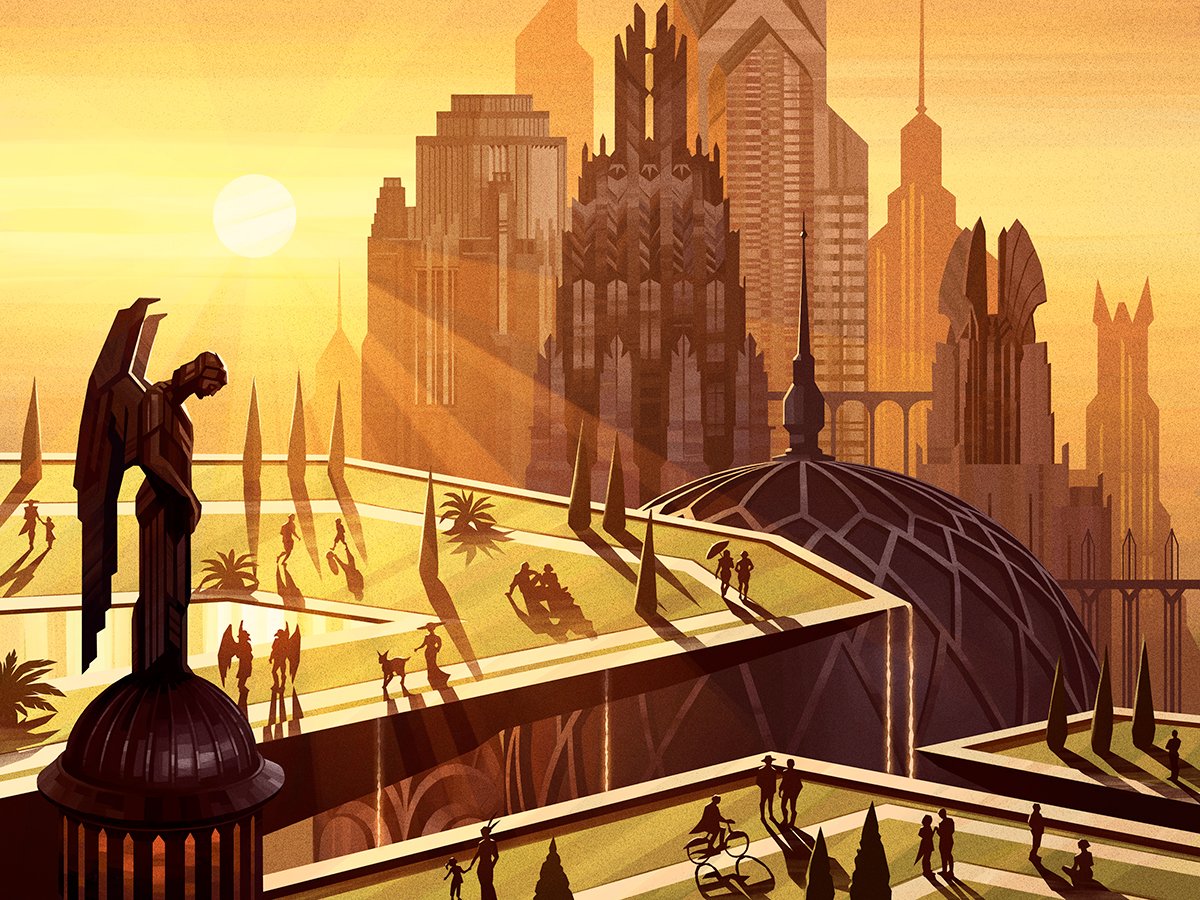
Botanical Garden by Olga Tereshenko. Digital.
There are two sides to New Capenna: the flashy and fabulous, one of glitz and glam, and the seedy and snarling underbelly wracked by crime bosses and the struggle for control. It’s only right that we see them both, to know exactly what we’re up against visiting here, and these juxtapositions extend across the entire landscape.
Glitz and glam:
Seedy and snarling underbelly:
These are places of bright light, or no lights at all, and from skyscrapers to back alleys, Capenna is full of nooks and crannies. Some of them belong to specific families and factions, hidden in plain sight, both on the ground:
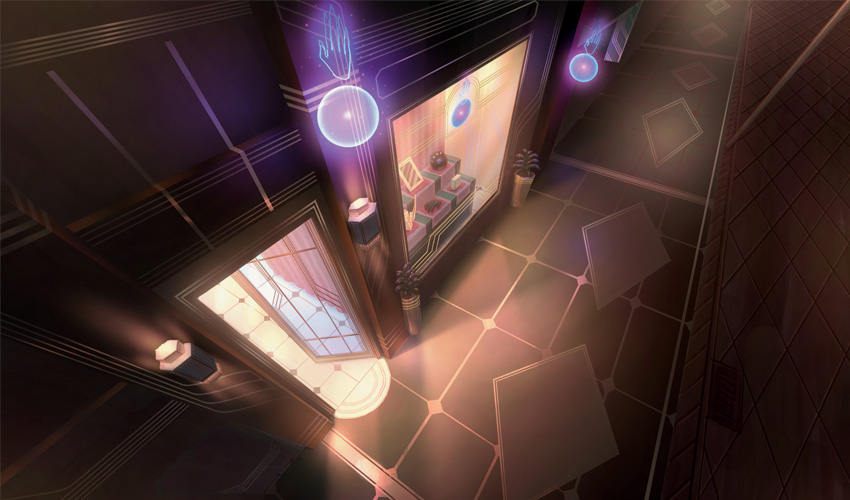
Obscura Storefront by Muhammad Firdaus. Digital.
And high in the sky:
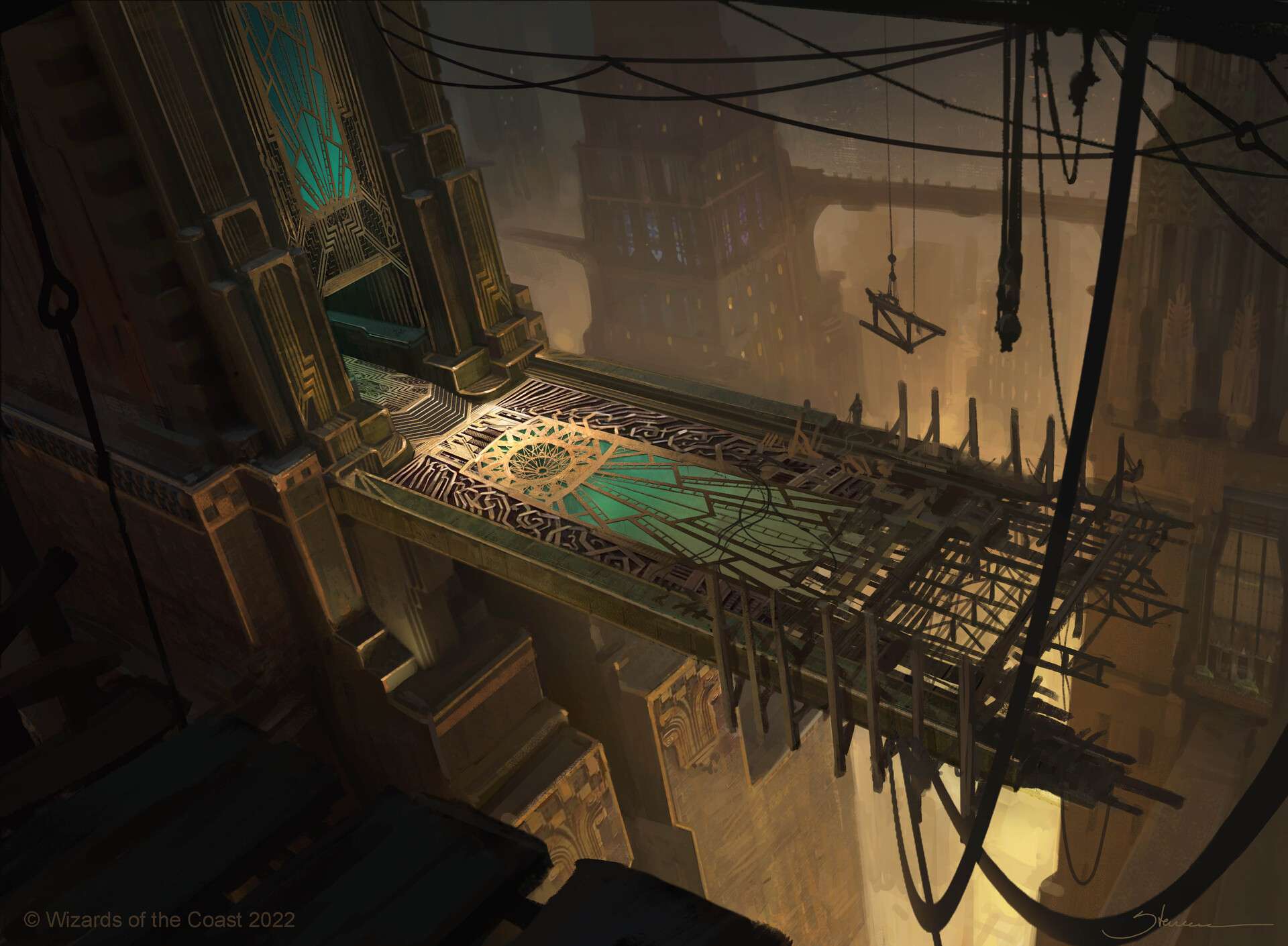
Riveteers Overlook by Lucas Staniec. Digital.
These places are unassuming, but yet incredibly important for worldbuilding:because they show how strained the inhabitants of the city really are. The dueling atmospheres create a mix of excitement and uneasiness; we’re not sure what’s around the next corner, but whatever it is, we’re excited for it, no matter where we find ourselves.
Disney Detail Level Two
“You’ve walked into town, you’ve just come to Main Street. You can see the parkway, the median strip, the trees, the benches.”
The second level of detail takes us deeper into the city, and begins to reveal the secrets that may (or may not, who’s asking) exist behind closed doors. In true New Capenna fashion, our arrival is met with warmest welcome and fanfare. Here in the city, when you’re in, you’re in!
We’re granted access to what lies ahead, but the door closes behind us. This level is still very much about setting the stage but from the Main Street perspective, more personal, more specific. We venture into identified locales of the five crime boss families, those places that only family members have access to.
These highly distinct, secluded places are often absent in the one block sets of contemporary Magic (think Ravnica vs. Ikoria). Their presence here not only shows their importance to the storyline, but enriches the overall world experience, both now and if we should ever return.
Disney Detail Level Three
“You’re standing on the sidewalk and now you’re looking at a fine house. You can see the color, the texture, the materials, the scale, the architectural style.”
At the third level, although we might be “in” we’re not necessarily a part of the action, not just yet. Rather we take on the role of the casual observer, a fly on the wall, to the comings and goings of Capenna family activity. The doors are open, and we can look inside.
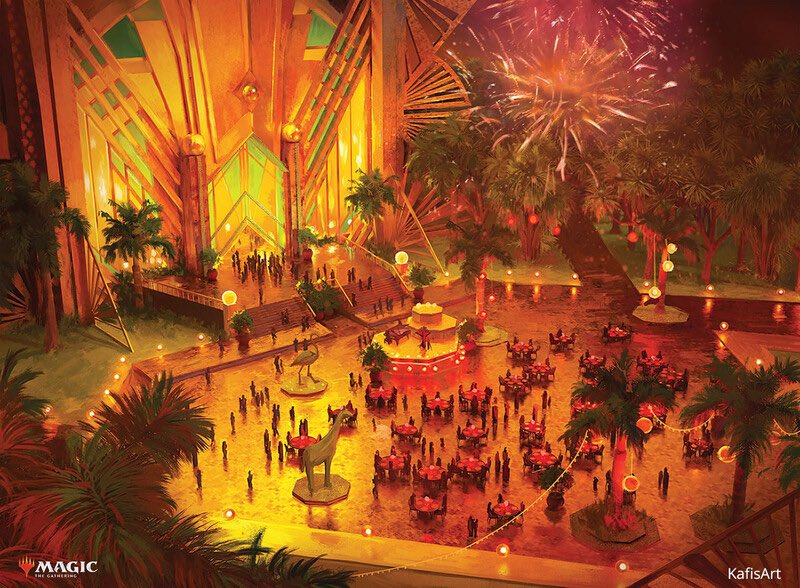
Cabaretti Courtyard by Kasia ‘Kafis’ Zielińska. Digital.
Depending on the door we’ve taken, we may encounter a lavish party of the Cabaretti, seen above, and inside, below:
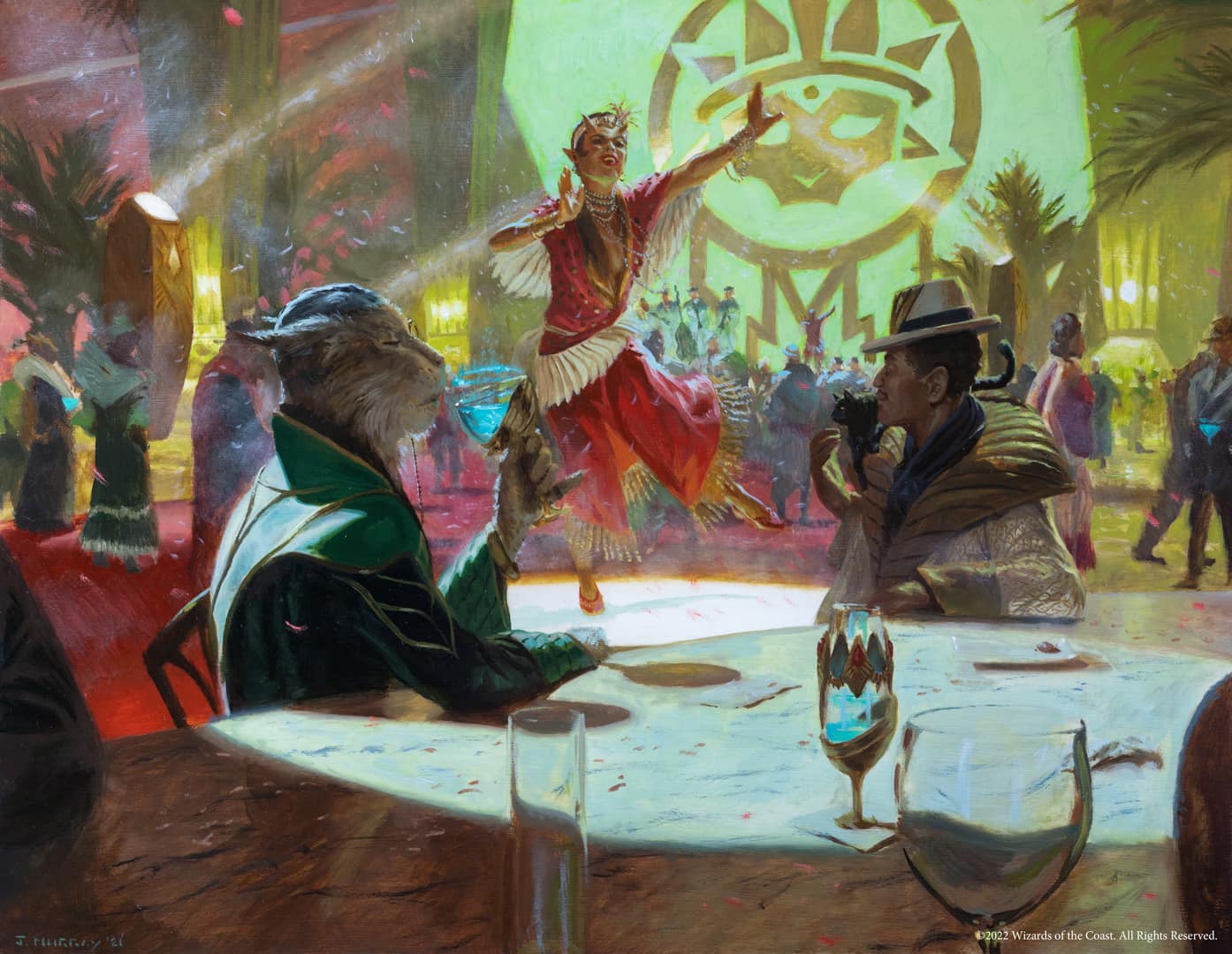
Cabaretti Confluence by Jake Murray. Traditional.
Or a different sort of party entirely, where hard working folks are just trying to get what’s owed to them.
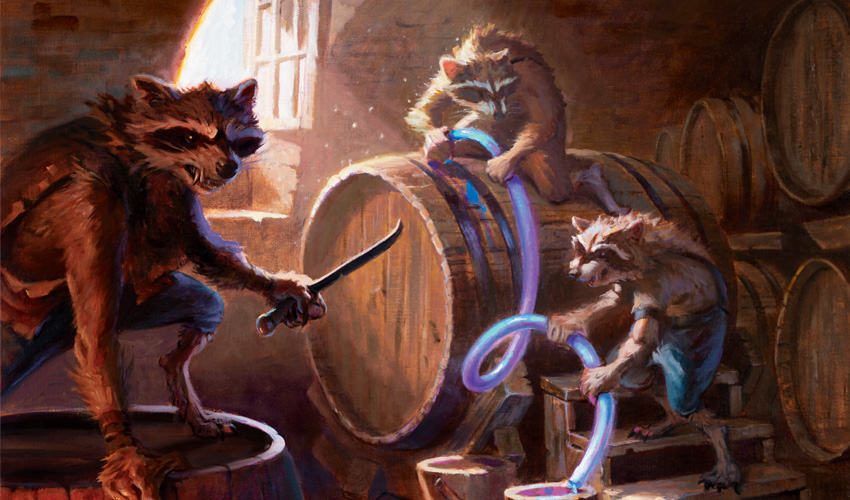
Smuggler’s Share by Aaron Miller. Traditional.
Or perhaps we find ourselves eavesdropping on a conversation across the room, that is, until someone unexpected looks up. Now we’re caught, and they know we’re here.
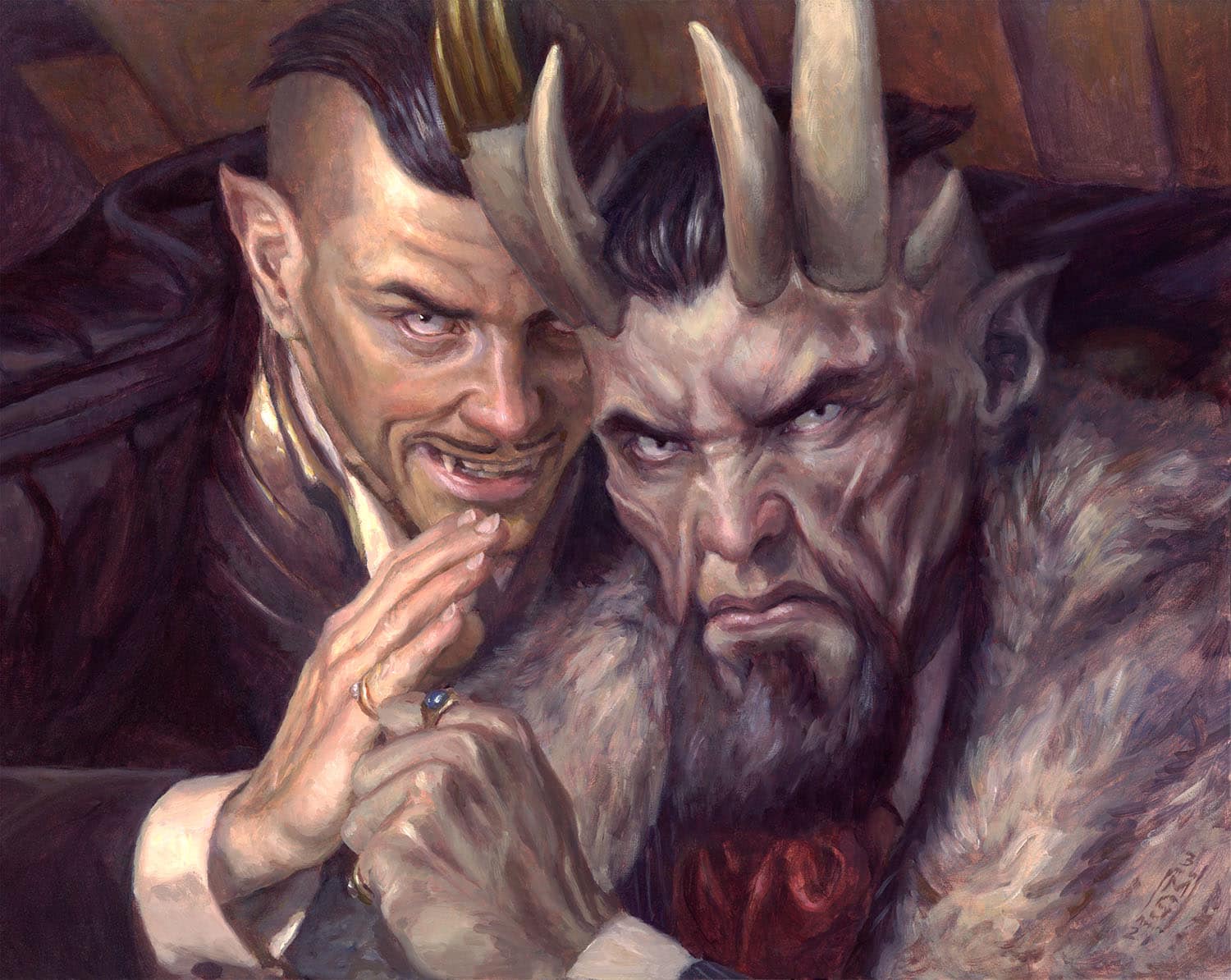
A Little Chat by Matt Stewart. Traditional.
The jig is up, and we’re in deep now. It’s time to face the music.
Disney Detail Level Four
“You’ve actually gone up to the front door and you’ve grabbed the door knocker and you’re knocking on the door, feeling the temperature of the metal and the texture of the metal, whether or not it’s been deformed, if there’s paint on it, if the paint is slightly chipped.”
I explained last time that there is no singular delineation of Disney’s Fourth Level of Detail. By its definition, it’s designing down to texture and temperature and irregularity of physical objects, as we see in Disney, and as we saw on Kamigawa. And while this is true of New Capenna as well, the fourth level also takes a different form.
It’s at this level we become a part of the story, and get a piece of the action, whether we’d like it or not. We are no longer looking from above, or from the street, or the fly on the wall. We are now face to face with the families we’ve been watching this whole time. We’ve gone from the thousand foot view to a foot from the person right in front of us, both good and bad.
Some are the friendly faces behind the bar, and we engage with an old friend we’d recognize anywhere:
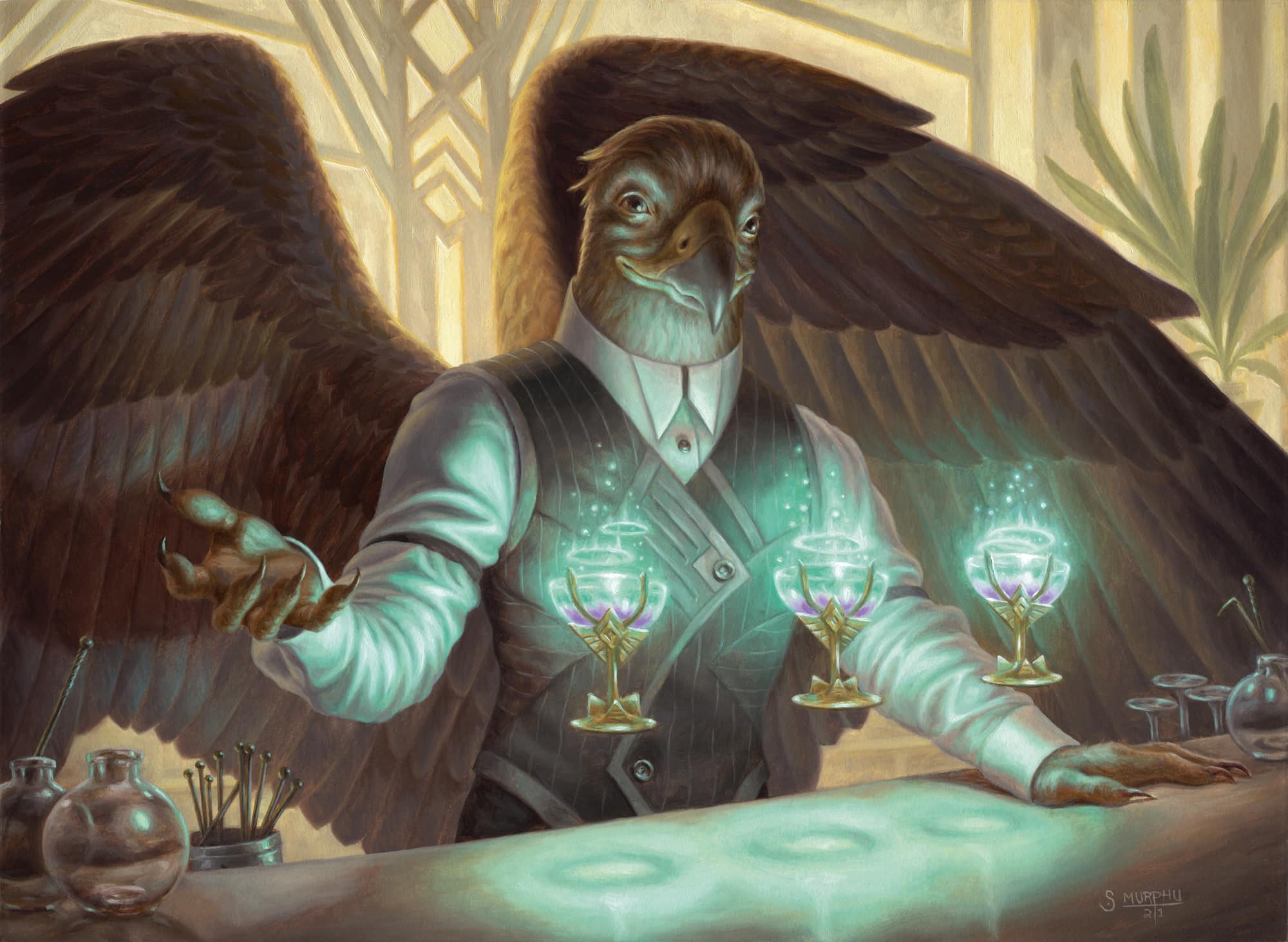
Speakeasy Server by Scott Murphy. Traditional.
And once we have our drink it’s off to the corner; the company is a little questionable, but it’s better than being alone I guess.
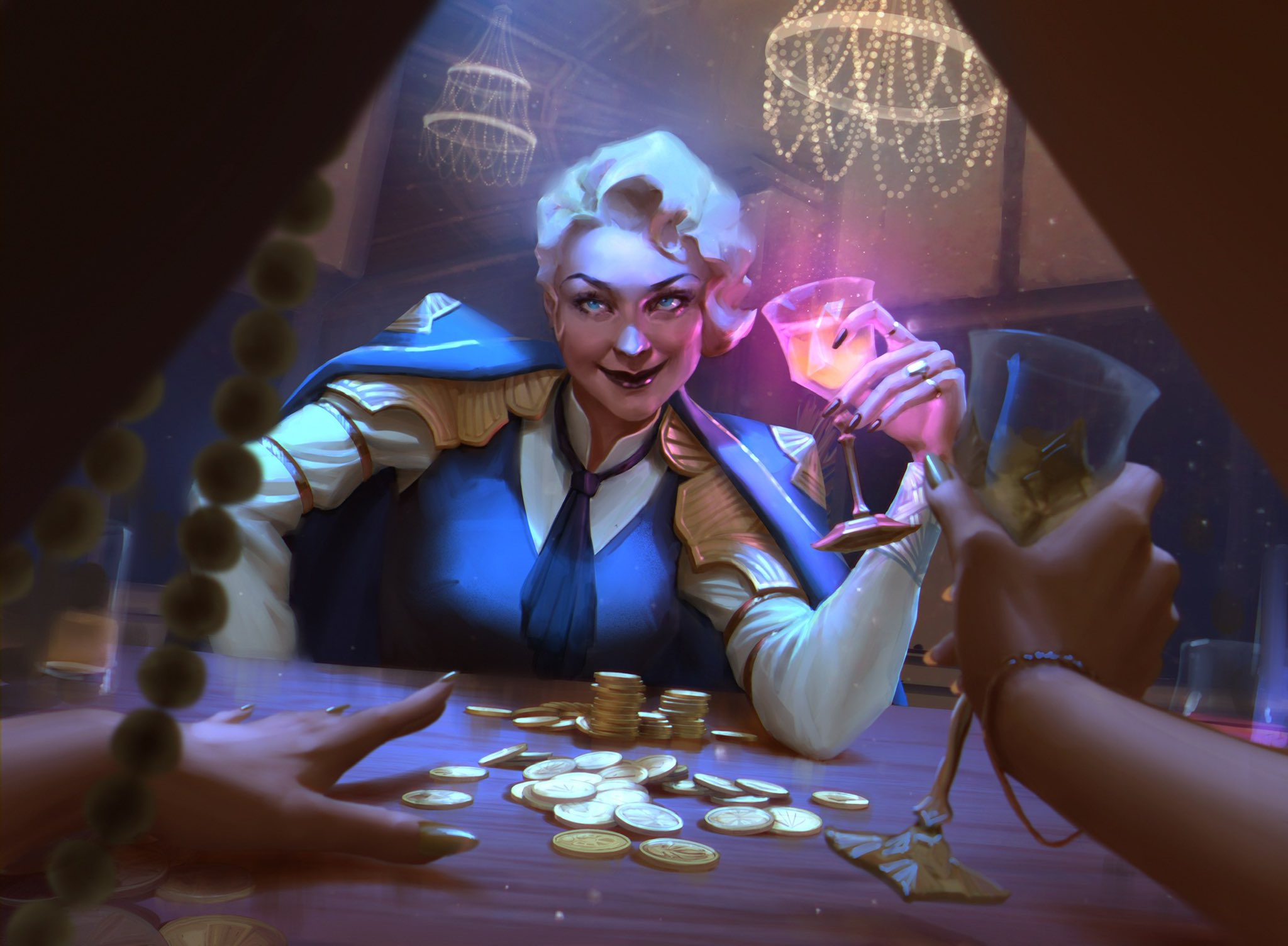
Tavern Swindler by Pauline Voss. Digital.
This artwork in particular lets us see precisely through the eyes of the sitter in the foreground. We are them, and we’ve become invested in what’s happening. Sometimes that even means we better get our dukes up, though, lest our face get rearranged
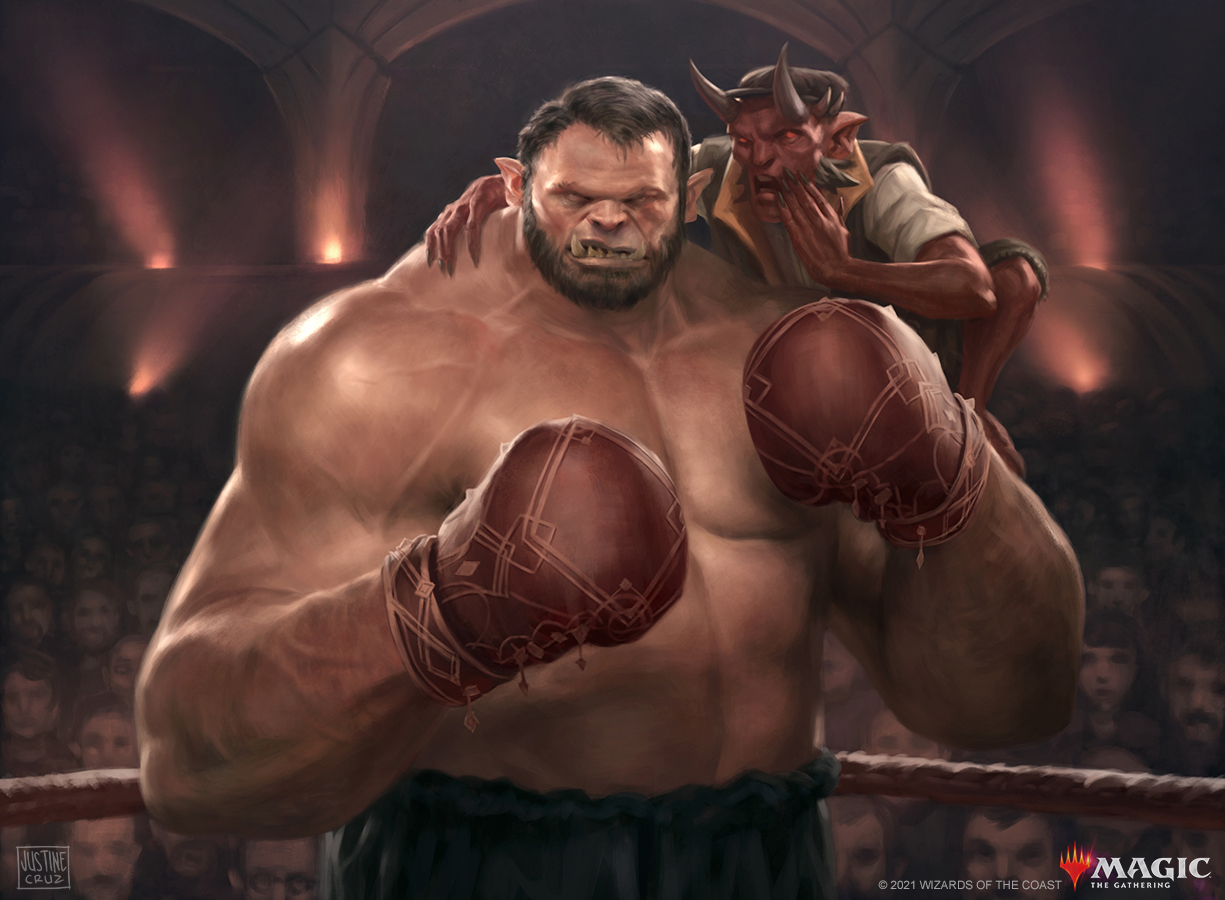
Pugnacious Pugilist by Justine Cruz. Digital.
Now fully immersed, we must be mindful of where we find ourselves. Because perhaps we’ve interrupted a meeting. Not a big deal, just the wrong door.
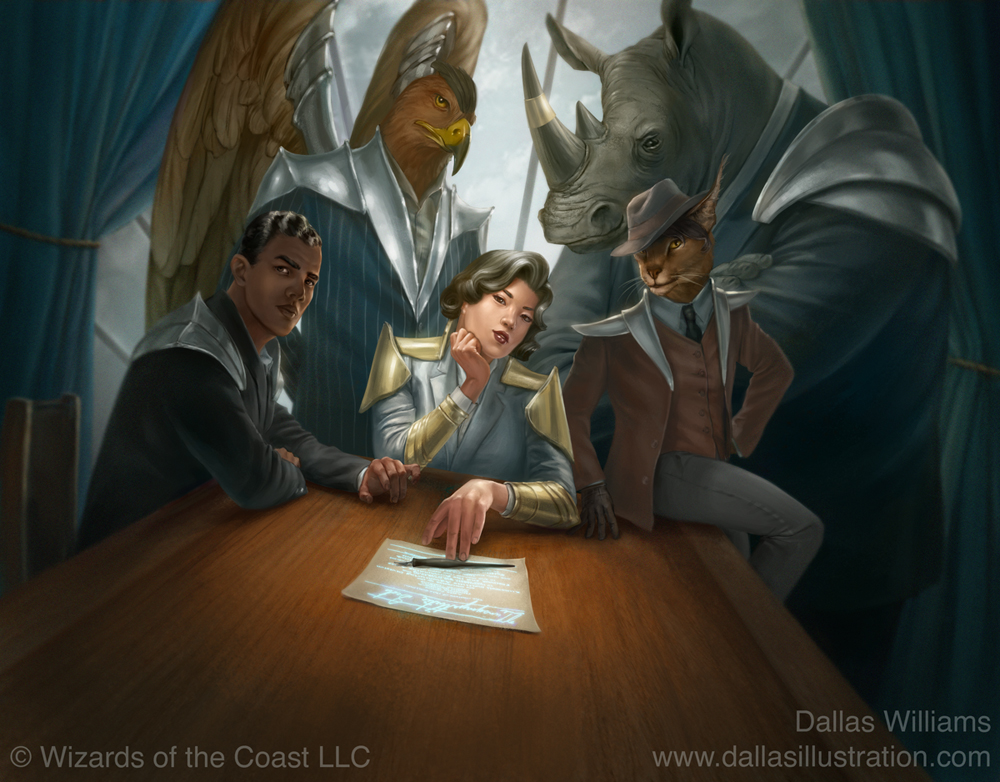
Broker’s Ascendancy by Dallas Williams. Digital.
Or maybe it’s a very big deal, and a very wrong door, as we meet the Families face to face in a very dark alley in a very remote part of the city.
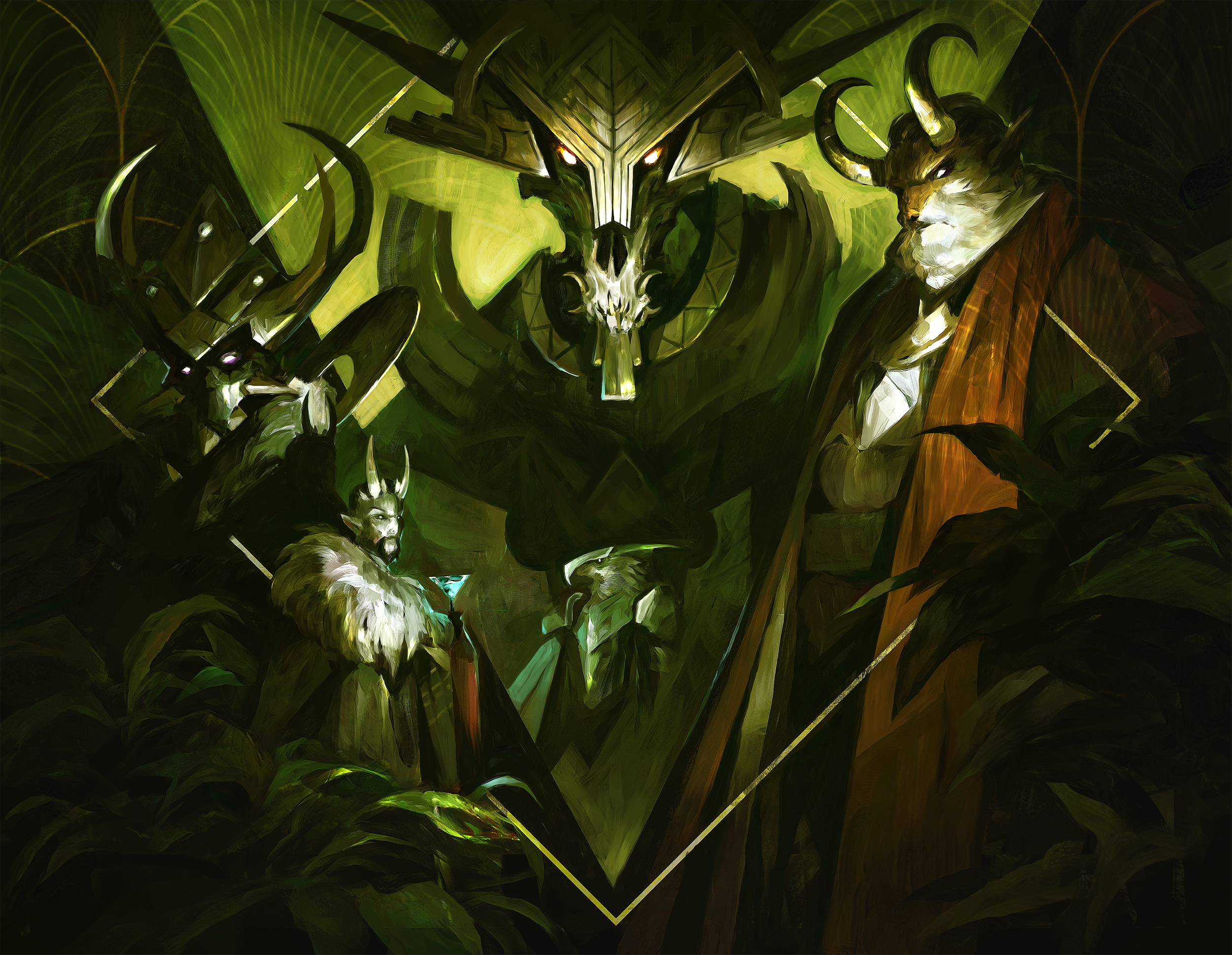
Meeting of the Five by Domink Mayer. Digital.
These artists and artworks break the fourth wall and interact with the view directly. We meet the gaze of our subjects eye for an eye, and step through the frame and into the story. This isn’t about seeing how the figures of New Capenna experience their world, but how we would experience it if we were there. It’s a different take on weaving reality in fantasy, but is perhaps even more poignant than looking in from afar.
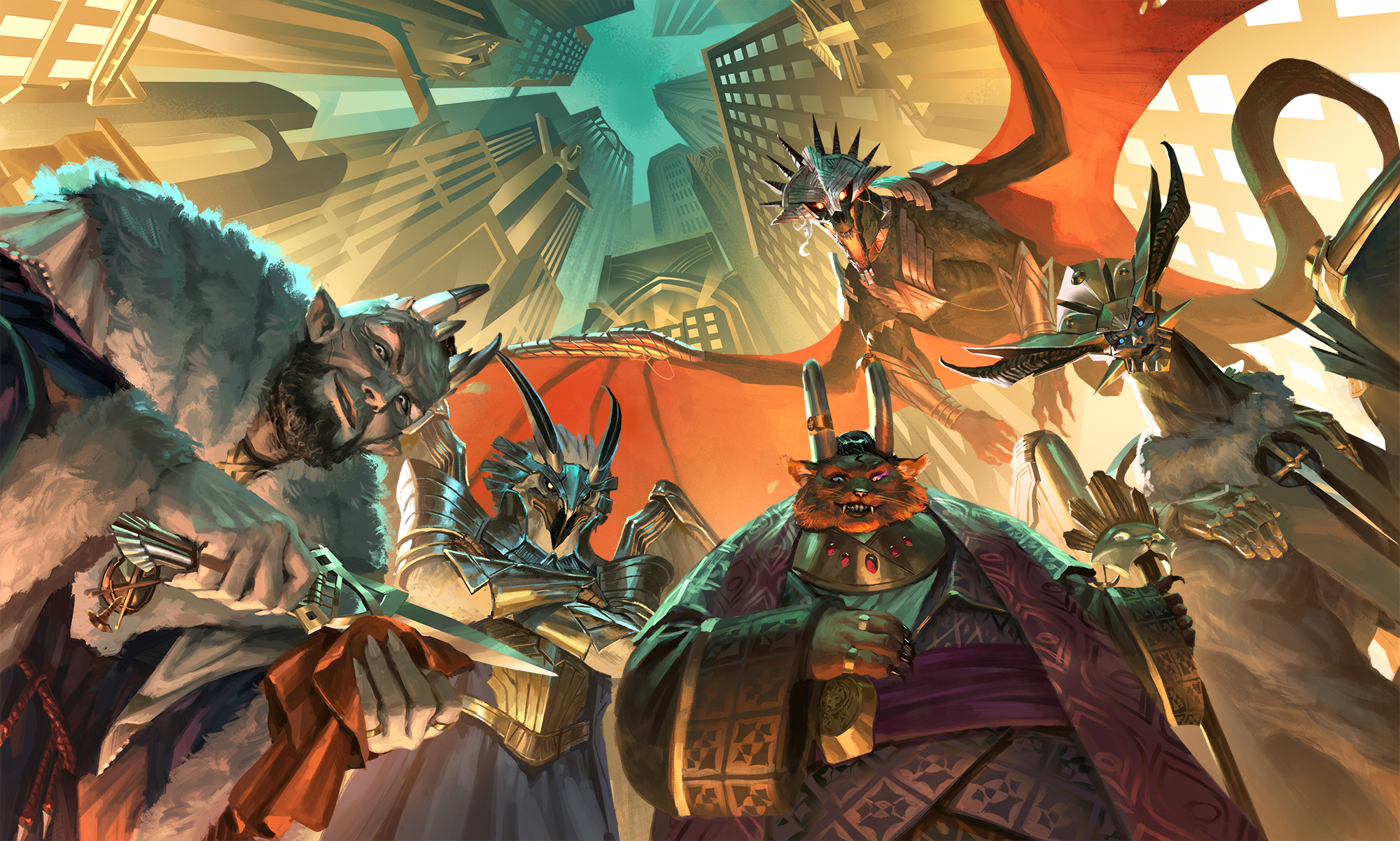
New Capenna Key Art by Benjamin Ee. Digital.
Wrapping Up
New Capenna provided an entirely new point of departure and application for the Four Levels of Detail, a rich world full of wonder and war that places us as the viewer squarely in the center by the time we’re through. As I mentioned, Streets of New Capenna has not only set the stage for what is happening now, but for an understood and meaningful return, either before or after these current events. This is a world Magic won’t forget, and all the building blocks have come together to create a unique environment that will almost certainly play a role in the game’s future.
Looking ahead to next month, we should be in for a double Grand Art Tour looking at both the currently previewing set of Commander Legends: Battle for Baldur’s Gate as well as the late summer release of Double Masters. I’ll also let my mind wander once more and publish the second article in a series that began with Mark Rothko last year, so stay tuned for that.
Remember, to see original #mtgart and other #vorthos related things, follow me on Twitter. Feel free to ask questions or retweet to continue the conversation. Thanks and see you next time!
Donny Caltrider has been playing Magic since 2002 and collecting original Magic art since 2017. He has an M.A. in Museum Studies from Johns Hopkins University and enjoys telling stories about art, objects, and the intersection of fantasy with real-life. You can find him on Twitter talking about #mtgart, museums, and other #vorthos related goodness. Follow along and continue the conversation!

